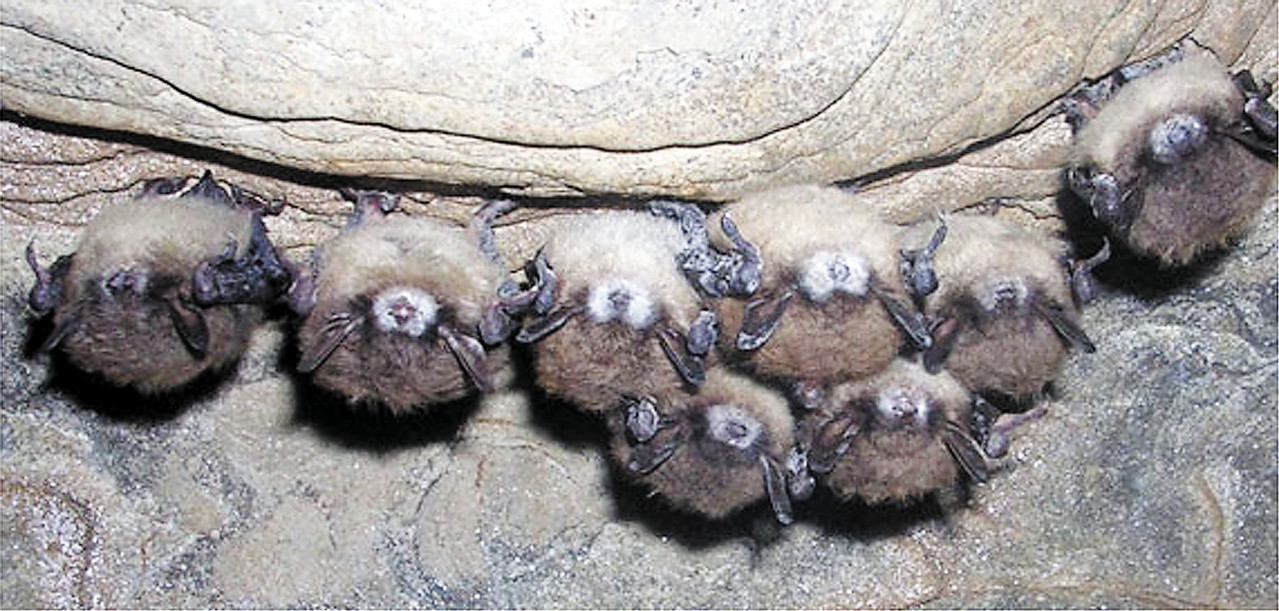Support the Timberjay by making a donation.
Bat epidemic poses challenges for Soudan
White-nose syndrome is decimating bat populations in eastern North America
A rapidly spreading disease has killed more than a million hibernating bats in eastern North America in the past four years, and that has officials at the Soudan Underground Mine State Park pondering …
This item is available in full to subscribers.
Attention subscribers
To continue reading, you will need to either log in to your subscriber account, or purchase a new subscription.
If you are a current print subscriber, you can set up a free website account and connect your subscription to it by clicking here.
If you are a digital subscriber with an active, online-only subscription then you already have an account here. Just reset your password if you've not yet logged in to your account on this new site.
Otherwise, click here to view your options for subscribing.
Please log in to continue |
Bat epidemic poses challenges for Soudan
White-nose syndrome is decimating bat populations in eastern North America
A rapidly spreading disease has killed more than a million hibernating bats in eastern North America in the past four years, and that has officials at the Soudan Underground Mine State Park pondering how to respond.
The park’s mine is home to thousands of bats, including the state’s largest known hibernating population of a species known as the little brown myotis. And while the disease has yet to show up in Soudan, park officials are worried that it could turn up at almost any time.
The disease, which has been dubbed white-nose syndrome, was first detected in a New York state cave in 2006. It has since spread to many dozens of cave sites throughout the northeastern U.S. and eastern Canada. And the disease is moving westward; it has already been reported in Oklahoma and Missouri.
When the disease does arrive, it is devastating to bats, said Jim Essig, park manager at Soudan. And in most cases, those who oversee the management of caves and mines don’t know they have a problem until it’s too late. “It’s really scary. Usually, the first symptom is a mass of dead bats,” said Essig.
The cause of the syndrome is not yet known, but it appears to be associated with a white fungus, which grows on the noses and faces of infected bats. Once infected, bat mortality is almost 100 percent according to the latest research on the disease.
It’s unclear whether the fungus is itself lethal, or if it irritates bats, forcing them out of hibernation too early. In caves infected with the fungus, bats have been reported to behave erratically, such as flying outside during daylight, clustering near the cave or mine entrance, or lying on the cave floor.
While the disease does not affect humans, the impact of the disease on bat populations could be cataclysmic. Indeed, researchers writing recently in Science Magazine predicted that the little brown myotis, eastern North America’s most common bat species, will face extinction in the northeastern U.S. within 16 years at current rates of spread.
While researchers believe the disease is spread primarily from bat to bat, wildlife managers also believe humans, particularly cavers, may be contributing to the transmission by carrying fungal spores on clothing. But the threat of transmission can go beyond the rather small group of people who actively explore caves regularly.
Many non-cavers do visit caves, or in the case of Soudan, former mines, with some frequency and those individuals can also spread the disease on their clothing or shoes.
Park officials at Mammoth Cave National Park, in Kentucky, are already prohibiting visitors from entering caves with clothing or other items that may have been in an infected cave at any time in the past five years.
So far, park officials in Soudan are stressing education, preferring to inform mine visitors of the dangers. But a state bat specialist is currently developing a statewide response plan that will likely increase the vigilance surrounding visitors who go underground at Soudan, or at Mystery Cave in southeastern Minnesota.
“I spent my first 20 years here trying to protect visitors from the bats, and now I’ll probably spend my next 20 years trying to protects bats from the visitors,” said Essig.
Bat populations vulnerable
Bat populations are extremely vulnerable to the effects of disease for at least two reasons. Since bats hibernate in large congregations, they are more likely to spread contagions. Bats are also slow to reproduce, with most female bats producing just one offspring, or pup, at a time. In some cases, bats may have more than one pup in a year, but rarely more than three, so when bat populations are decimated by disease or other factors, it can take a long time for them to recover.
Under normal circumstances, bats don’t need to reproduce that frequently, since many bats, once they reach adulthood, can live to 20 years or more and typically have many years to reproduce.






